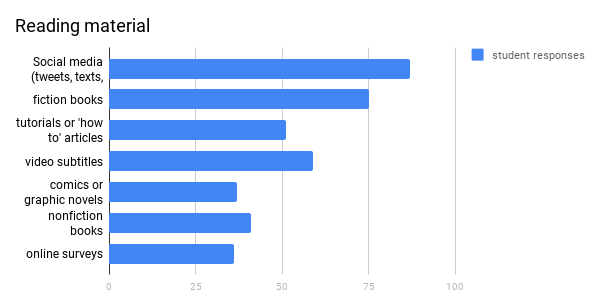Using short, frequent target language texts
Infusing your world language classroom daily with accessible texts is a powerful instructional practice.
“let us reed what we want to learn don't force us stuff we don't want to learn about”
A student scrawled this note at the bottom of her quiz. I wasn’t particularly impressed with her rather presumptuous feedback, especially considering her mediocre overall performance. This girl was frequently off task and clearly hadn’t put the work in to earn good grades. CLEARLY, her literacy skills were deficient. Now she doesn't want me to “force us stuff we don’t want to learn about”? And what would the alternative be? Reading Snapchat posts and learning about TikTok stars? Maybe if she applied herself, she could get interested in something more worthwhile.
“When selecting texts for use in our classroom, our choices should be intentional, not just dictated by tradition or what texts we have on hand. ”
I was sharing all these thoughts over dinner when my 15 year old daughter pointed out, “Mom, she didn’t say she doesn’t want to read. She asked you to let her read what she’s interested in.”
Hmm. I hadn’t looked at it that way. I went back and read my student’s comment again; my daughter was right. I had totally overlooked the honest request, “let us reed what we want to learn”.
This prompted me to examine my own reading habits.
On a typical school day,
In my daily life, much of my reading is in short bursts
What type of reading do I do? Why?
How much of my reading is long and sustained? How much comes in short bursts?
How challenging is the reading I do on a typical day?
How much is on topics I’m interested in or choose myself and how much is dictated?
My school day starts early as I get myself and my children ready for the day ahead. When I get to school I’ll usually check my e-mail and write a few replies. I review my lesson plans for the day and if I have time, grade a few papers. During lunch, I may read a quick news article, text, or social media post, or I may stick with work-related grading and lesson planning. When I get home in the evenings I usually read a chapter of a book to my children and help them with homework. After their bedtime I may pick up a book for enjoyment… but sometimes I’m so tired at this point I fall asleep!
I love reading and I’m a good reader, but most of my daily reading comes in short bursts. Long, sustained reading is part of my life, and typically I don’t do much heavy or difficult reading at all, at least not during the school year. Sometimes I’ll read something challenging, but usually this is because I’m highly interested in the topic or I really need the information.
Now let’s think about students.
“There’s a place for traditional books and longer articles, but there’s also value in infusing lots of short texts throughout daily instruction.”
On a typical day, how much do they read?
How much of that reading is in short bursts? How much is long and sustained?
How much of a students’ reading is challenging for them?
How much is dictated, and how much is on topics they are interested in?
I had my own guesses, but I decided to ask my students what they read outside of class. Here are the survey results:
48 high school students’ responses to “What do you read on your own? (not required for school)
These results were fascinating, and certainly can inform my world language instruction. While kids in my classes do read books, a large part of their reading - like mine - is in short bursts from non-academic sources. If I wanted my language instruction to be something my students would use in their daily lives, I needed to make some changes.
In school, students are often asked to read long, difficult texts for sustained periods of time. There is a place for this, of course - but there’s also a place for shorter texts and graphic texts like memes, infographics, text messages, and advertisements. Shorter reading selections are more manageable, allow time for pinpointed focus on a grammar or vocabulary point, and are more in line with the length of text students will encounter in real target language usage.
What our students wish we knew
I also asked my students, “What do teachers need to know about students’ reading habits?” Some of their replies:
If it’s interesting, there’s a good chance we will read it.
Teenagers read a lot based on the things they actually want to know more about, like what's going on with celebrities or in the makeup/drama world.
We typically don't read things like physical books, at least not willingly, and most teenagers are more likely to read and learn more when they read something on an electronic device.
They need to pick something recent and what we can relate to
That not everyone loves to read, and they might need to accommodate for that.
That we do read just most of us don't read actual books any more
We read more than they might think
Some teens don't read because they believe books are boring so they read magazines or social media...if its tutorial on how to do makeup or play a video game or comparing something they like, they will read it
Students read more than we may think!
I found these survey results fairly positive. Some takeaways:
Kids really DO read - just not the way we may think!
Use the internet! Use electronic texts!
Incorporate social media & ‘non-traditional’ texts
Include current / pop culture topics
Give students some choices in what they read
Give students exposure to different lengths of texts. There’s a place for traditional books and longer articles, but there’s also value in infusing lots of short texts throughout daily instruction.
When selecting texts for use in our classroom, our choices should be intentional, not just dedicated by tradition or what texts we have on hand. Here are a few easy-to-implement ideas to incorporate different types of short texts into instruction.
Easy-to-implement Short Texts
Target language memes are highly engaging!
Memes - I especially love using memes with novice learners. They’re visual, funny, and relevant. Students are highly motivated to access this medium they enjoy reading in English. To find memes, go to a target language browser (Google.fr / Google.es for example) and search for memes. I’ve found a few accounts where I can reliably find usable content for my students; Here’s one I like for French. Be sure to always preview, since not everything is school appropriate. And, if you have a great meme resource for other languages, please post in the comments
Infographics - infographics are an outstanding entry point into new content, providing contextual and visual cues to incorporate new vocabulary. Like with memes, infographics are easy to find with a target language search of “infographic on (topic)”. Click the links for a free reading and vocabulary lesson using infographics in French and in Spanish.
Newspaper headlines. Select a headline from today’s target language newspaper. Take a few minutes to understand the headline, discuss unknown vocabulary, identify key people or events, and locate the country of the headline on a map. This activity can easily be adapted for different levels and can be used as a quick warm up or can be expanded into current events discussion, reading, or writing activities. It’s also good for incorporating various communities within the target culture (such as the huge variety of francophone countries). Thanks to my amazing colleague, French teacher Cyndi Deppong, who shared this idea and created this slideshow à la une slideshow with tips for implementing headlines along with links to a variety of French language news sites.
Wikipedia Ribbons - most students are familiar with Wikipedia and recognize it as a source they would use. Having students investigate the target language Wikipedia ribbon for most any topic is an engaging way to introduce vocabulary, teach reading strategies, and build confidence. I often use this resource with a disengaged student; have them look up the Wikipedia page for their favorite athlete or video game and see what target language vocabulary they can figure out. They’ll be able to do some, and this is empowering.
YouTube comments - again, students are highly motivated by reading the comments; this is a familiar format, is broken into short, manageable bits, and includes the slang and casual language students are always asking for. You can share screenshots of pre-selected comments, or turn students loose to choose their favorites. I also love having students correct the grammar errors in viewer comments: I often find errors even my beginning students can correct! Here’s a link to a ready-made viewer comment exercise for the Erza Muquoli song, “Je Chanterai”.
Those are just a few ideas to bring more reading into your classroom! Please share your own ideas for using short texts in the chat. And, for ideas to effectively introduce vocabulary in a target language text, check out part 3 of this blog post!





